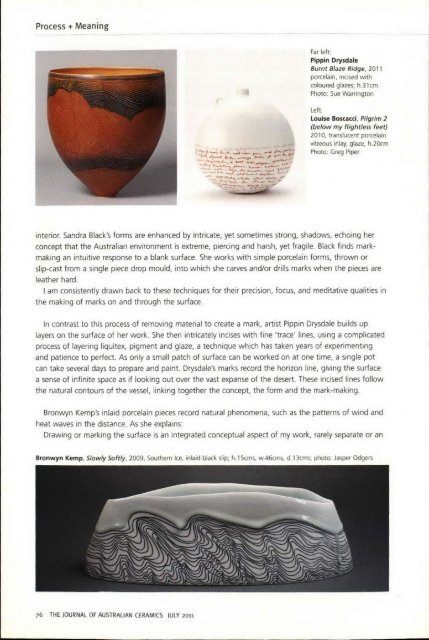The Journal of Australian Ceramics Vol 50 No 2 July 2011
Create successful ePaper yourself
Turn your PDF publications into a flip-book with our unique Google optimized e-Paper software.
Process + Meaning<br />
Far left:<br />
Pippin Drysdale<br />
Burn t Blaze Ridge, <strong>2011</strong><br />
porcelain, incised with<br />
coloured glazes; h.31cm<br />
Photo: Sue Warrington<br />
left:<br />
louise B05cacci, Pilgrim 2<br />
(below my flightless feet)<br />
2010, translucent porcelain<br />
vitreous inlay, glaze, h.20cm<br />
Photo: Greg Piper<br />
interior. Sandra Black's forms are enhanced by intricate, yet sometimes strong, shadows, echoing her<br />
concept that the <strong>Australian</strong> environment is extreme, piercing and harsh, yet fragile. Black finds markmaking<br />
an intuitive response to a blank surface. She works with simple porcelain forms, thrown or<br />
slip-cast from a single piece drop mould, into which she carves and/or drills marks when the pieces are<br />
leather hard.<br />
I am consistently drawn back to these techniques for their precision, focus, and meditative qualit ies in<br />
the making <strong>of</strong> marks on and through the surface.<br />
In contrast to this process <strong>of</strong> removing material to create a mark, artist Pippin Drysdale builds up<br />
layers on the surface <strong>of</strong> her work. She then intricately incises with fine 'trace' lines, using a complicated<br />
process <strong>of</strong> layering liquitex, pigment and glaze, a technique which has taken years <strong>of</strong> experimenting<br />
and patience to perfect. As only a small patch <strong>of</strong> surface can be worked on at one time, a single pot<br />
can take several days to prepare and paint. Drysdale's marks record the horizon line, giving the surface<br />
a sense <strong>of</strong> infinite space as if looking out over the vast expanse <strong>of</strong> the desert. <strong>The</strong>se incised lines follow<br />
the natural contours <strong>of</strong> the vessel, linking together the concept, the form and the mark-making.<br />
Bronvvyn Kemp's inlaid porcelain pieces record natural phenomena, such as the patterns <strong>of</strong> wind and<br />
heat waves in the distance. As she explains:<br />
Drawing or marking the surface is an integrated conceptual aspect <strong>of</strong> my work, ra rely separate or an<br />
Bronwyn Kemp, Slowly S<strong>of</strong>tly, 2009, Southern Ice, inlaid black slip; h.15cms, w.46cms, d. 13cms; photo: Jasper Odgers<br />
76 THE IOURNAL OF AUSTRALIAN CERAMICS JULY <strong>2011</strong>

















